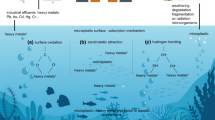Abstract
Organotins, and more specifically tributyltins (TBT), are introduced into the marine environment by paints designed to protect ship hulls against biological fouling. Lab tests have shown that bivalve reproduction is affected by TBT concentrations exceeding 20 ng⋅l−1. A dose-effect correlation scale describes the effects on embryogenesis and on larval growth: total larval mortality occurs after 12 days of exposure at a concentration of 200 ng⋅l−1, and inhibition of fertilization at 100 μg⋅l−1. At concentrations close to 1 ng⋅l−1, significant changes are observed in the sexuality of marine gastropods, reflected in an imposition of male characters in females, a phenomenon known as imposex. Imposex evolution in Nucella lapillus females includes: formation of a vas deferens, a channel between prostate and penis existing in males (phase 1), appearance and growth of a penis (phases 2 to 4), sterilization of the subject with blocking of the oviduct and accumulation of eggs within the gland (phases 5 to 6). In the final stages, females become sterile, thereby jeopardizing population renewal. These disturbances occur following exposure at TBT concentrations of 7 to 12 ng⋅l−1 approximately. Physiological and biochemical phenomena leading to imposex are still not well understood. However, there are evidences that TBT exposure tends to increase the testosterone contents in female mollusks, while progesterone and 17 E oestradiol levels remain constant. Since testosterone alone causes penis growth in the females, it is thought that imposex could be attributed to its accumulation originating from inhibition of cytochrome P450-dependent aromatase. The conversion of testosterone into 17 E oestradiol would then be inhibited by TBT. In spite of regulations banning the use of TBT as biocide in antifouling paints, current TBT contamination in coastal areas frequently reaches concentrations likely to cause imposex.
Similar content being viewed by others
References
Alzieu, Cl. and Michel, P. (1998). L'étain et les organoétains en milieu marin: biogéochimie et ecotoxicologie. Repères Océan, Edit IFREMER, 15, 104 p.
Chagot, D., Alzieu, Cl., Sanjuan, J. and Grizel, H. (1990). Sublethal and histopathological effects of trace levels of tributyltin fluoride on adult oysters Crassotrea gigas. Aquat. Living Ressour. 3, 121-30.
de Mora, S.J. (1996). Tributyltin: case study of an environmental contaminant. Cambridge Environmental Chemistry Series 8, 311 pp.
Fent, K. (1989). Organotin speciation in municipal wastewater and sewage sludge: ecotoxicological consequences. Mar. Environ. Res. 28, 477.
Fent, K. (1996). Ecotoxicology of organotin compounds. Critical Reviews in Toxicology 26, 1-117.
Féral, C. and Legall, S. (1982). Induction expérimentale par un polluant marin, le tributylétain, de l'activité neuro endocrine controlant la morphogenèse du pénis chez les femelles d'Ocenebra erinacea, Mollusque, Prosobranche gonochorique. C.R. Acad. Sci Paris 295(III), 627-30.
Gibbs, P.E., Bryan, G.W., Pascoe, P.L. and Burt, G.R. (1987). The use of the dogwhelk (Nucella lapillus) as an indicator of TBT contamination. J. Mar. Biol. Assoc. UK 67, 507-24.
Gibbs, P.E. and Bryan, G.W. (1996). TBT induced imposex in neogastropod. In S.J. de Mora ed Tributyltin: case study of an environmental contaminant. Cambridge Environmental Chemistry Series 8, 212-36.
Hassan, M.A. and Juma, H.A. (1992). Assessment of tributyltin in the marine environment of Bahrain. Mar. Pollut. Bull. 24, 408.
His, E. and Robert, R. (1983-1985). Développement des véligères de Crassotrea gigas dans le bassin d'Arcachon. Etudes sur les mortalités larvaires. Rev. Trav. Inst. Pêches Marit. 47, 1-2, 63-88.
IPCS. (1990). Environmental Health Criteria 116-Tributyltin Compounds, 273 p. Geneva: WHO.
Iwata, H., Tanabe, S., Miyazaki, N. and Tatsukawa, R. (1994). Detection of butyltin compound residues in the blubber of marine mammals. Mar. Pollut. Bull. 28, 607.
Lascourrèges-Berdeü, J.F. (1996). Rôle des Sulfatobactéries dans la Remobilisation et la Transformation des Metaux et des Composés Organostanniques Butylétain et Phénylétains Stockés dans les Sédiments Lagunaires, No. 1530, 232 p. Thèse, Université de Bordeaux I, France.
Law, R.J., Waldock, M.J., Allchin, C.R., Laslett, R.E. and Bailey, K.J. (1994). Contaminants in sea water around England and Wales: results from monitoring surveys, (1990-1992) Mar. Pollut. Bull. 28, 668.
Maguire, R.J. (1987). Environmental aspects of tributyltin. Appl. Organomet. Chem. 1, 475-98.
Matthiessen, P. and Gibbs, P.E. (1998). Critical appraisal of the evidence for tributyltin-mediated endocrine disruption in mollusks. Environ. Toxicol. Chem. 17(1), 37-43.
May-ming Lau, M. (1991). Tributyltin antifoulings: a threat to the Hong Kong marine environment. Arch. Environ. Contam. Toxicol. 20, 229.
Michel, P. and Averty, B. (1999). Contamination of French coastal waters by organotin compounds: 1997 update. Mar. Pollut. Bull. 38(4), 268-75.
Ronis, M.J.J. and Mason, A.Z. (1996). The metabolism of testosterone by the periwinkle (Littorina littorea)in vitro and in vivo: effects of tributyltin. Mar. Environ. Res. 42, 161-6.
Smith, B.S. (1981). Tributyltin compounds induced male characteristics on female mud snails Nassarius obsoletuss = Tlyanassa obsoleta. J. Appl. Toxicol. 1(3), 141-4.
Stewart, C. and de Mora, S.J. (1990). A review of the degradation of tri(n butyl)tin in marine environment. Environ. Technol. 11, 565-70.
Stewart, C. and Thompson, J.A.J. (1994). Extensive butyltin contamination in southwestern coastal British Columbia, Canada. Mar. Pollut. Bull. 28, 601.
Uhler, A.D., Durell, G.S., Steinhauer, W.G. and Spellacy, A.M. (1993). Tributyltin levels in bivalve mollusks from the east and west coast of the United States: results from the 1988-1990 national status and trends mussel watch project. Environ. Tech. Chem. 12, 139-53.
Wade, T.L., Garcia-Romero, B. and Brooks, J.M. (1990). Butyltins in sediments and bivalves from US coastal areas. Chemosphere 20, 647.
Waldock, M.J., Thain, J.E. and Miller, D. (1983). The accumulation and depuration of bis, tributyltin oxyde in oysters: a comparison between the Pacific oyster, Crassostrea gigas and the flat European oyster, Ostrea edulis. ICES C.M. 1983/E, 59.
Watanabe, N., Sakai, S. and Takatsuki, H. (1992). Examination for degradation paths of butyltin compounds in natural waters. Wat. Sci. Tech. 25(11), 117-24.
Author information
Authors and Affiliations
Rights and permissions
About this article
Cite this article
Alzieu, C. Impact of Tributyltin on Marine Invertebrates. Ecotoxicology 9, 71–76 (2000). https://doi.org/10.1023/A:1008968229409
Issue Date:
DOI: https://doi.org/10.1023/A:1008968229409




